Lawn Insect Control
Contender’s controls common insects that ruin lawns
Contender’s controls common insects that ruin lawns
Contender’s controls common insects that ruin lawns
If you’re experiencing dead, yellowed or brown patches of grass, you may have a lawn insect problem on your hands. These pests feed on the turf blades, turning patches yellow/brown with their saliva. Contender’s lawn experts provide lawn insect control service that can help you diagnose which insects are causing this unsightly damage and treat it accordingly. Whether you have Sod Webworms, Chinch Bugs, Bluegrass Billbugs, Grubs or European Crane Flies, we can create a lawn insect plan to start restoring your lawn to its former glory.
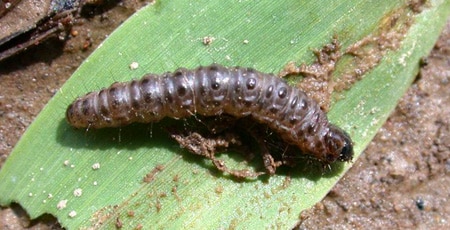
A brownish-green caterpillar about 3 inches long. Sod Webworms eat blades of grass at the base, causing them to fall over.
Dead or brown patches in your lawn that are about 4-6 inches in diameter. In the early morning you may even see what appears to be a spider’s web at the base of the dead patch. These patches will spread over a large area of the lawn and will cause a general thinning appearance due to these lawn insects.
Our lawn experts will determine the best control options at the time. In some instances you may have contacted us at the tail end an insect’s life cycle which means we will be honest and fair asking you to save your money but plan for the future hatchings. Important to understand that insects have far reaching migratory options and yearly protection will be prudent when a history of problems have been identified.
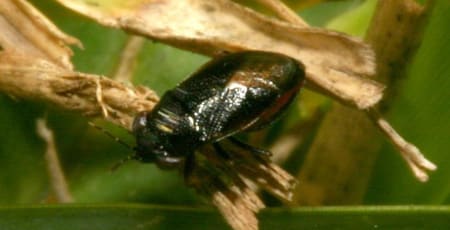
A tiny beetle about 1 centimeter long. Mature Chinch Bugs have black and white coloring. They suck the juices out of the grass blade, causing it to turn yellow.
A general browning of the lawn. It will appear that the lawn is just drying up from lack of water, even though you are watering regularly. The entire blade of grass will turn yellow or brown from the ground up to the tip. It will be most common along driveways and sidewalks where the soil is warmest. Lawns that have a high percentage of fine fescue in their population have a higher chance of seeing chinch bug damage.
Our lawn experts will determine the best control options at the time. In some instances you may have contacted us at the tail end an insect’s life cycle which means we will be honest and fair asking you to save your money but plan for the future hatchings. Important to understand that insects have far reaching migratory options and yearly protection will be prudent when a history of problems have been identified.
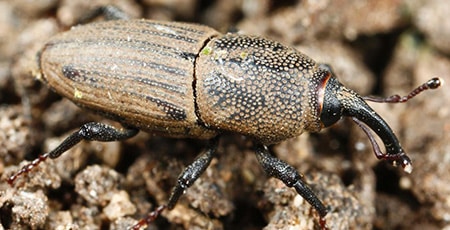
In its tiny grub stage, a Bluegrass Billbug eats the grass stem from the inside out. As an adult black beetle, it sucks the juices out of the blades, causing damage as well.
A general yellowing of sections of the lawn. Each of the grass blades will be yellow, and if you gently tug on the blade, it may pull right up from the base.
Our lawn experts will determine the best control options at the time. In some instances you may have contacted us at the tail end an insect’s life cycle which means we will be honest and fair asking you to save your money but plan for the future hatchings. Important to understand that insects have far reaching migratory options and yearly protection will be prudent when a history of problems have been identified.
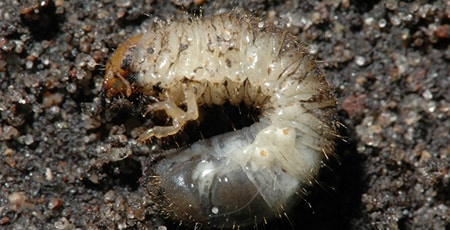
Predecessor of the local European Chafer, Japanese and June Beetles. Hatched in Summer, grubs feed on the grass root system from late Summer through Fall, burrow in Winter soil and feed again in Spring.
One of two situations: Either you’ll notice that skunks or other animals are digging up your lawn or that large sections of your lawn are turning brown. Either way, you already know there is a problem! We normally see grub problems either in the late spring or the late summer and fall periods. However, you may occasionally see damage in the heat of the summer.
Our lawn experts will determine the best control options at the time. In some instances you may have contacted us at the tail end an insect’s life cycle which means we will be honest and fair asking you to save your money but plan for the future hatchings. Important to understand that insects have far reaching migratory options and yearly protection will be prudent when a history of problems have been identified.
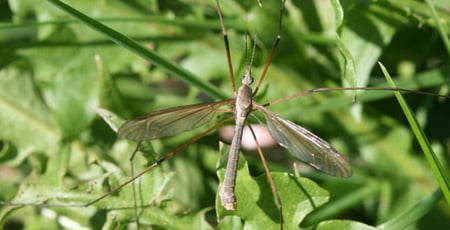
Giant mosquito-like insect that devours grass from the leaf blade and down to the root system before eventually devouring the crown – virtually denying any chance of recovery.
Giant mosquito-like insects flying daintily across your lawn and hanging on your home. In May, you can see the larval stage with hundreds of green worms crawling across the ground on lawns and driveways. Damage to the lawn will exhibit thinning areas that within 2-3 weeks can become completely bare soil. May is the month where severe damage is most noticeable.
This invasive insect species originated from Europe and in 2002 invaded Canada, where it has now found its way into Michigan as early as 2010. The ECF, European Crane Fly, is capable of laying 300 eggs. Japanese Beetles can only lay 50 grub eggs so the potential for severe infestation levels is dramatically higher with the ECF compared to grubs. The ECF is a comprehensive feeder of the entire grass structure and its appetite for feeding allows it to consume large volumes of foliage within several days. ECF females prefer to lay their eggs in moist turf where it is most viable for their young to survive. Well irrigated lawns in the fall will provide adequate habitats for the ECF to survive.
Our lawn experts will determine the best control options at the time. In some instances you may have contacted us at the tail end an insect’s life cycle which means we will be honest and fair asking you to save your money but plan for the future hatchings. Important to understand that insects have far reaching migratory options and yearly protection will be prudent when a history of problems have been identified.
